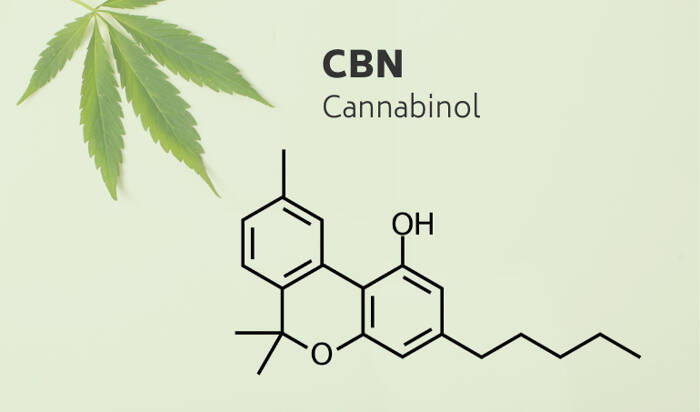What is CBN and CBDL ? – All About Cannabinols and Cannabinodiols, Introduction, Medical Benefits, Legality and More
About the CBNs, CBDLs and Other Cannabinoids
Cannabinols have some mild intoxicating actions and are found at higher levels in aged cannabis. The cannabinols appear to be degradation products of THC and THCA. The CBNs as a group have been tested in various animal models. CBNs appear to exhibit some toxicity and mutagenicity. When zebrafish embryos are exposed to these materials, an increase the frequency of anatomic anomalies was noted. [1]
In a rat model for facial pain, different combinations of CBD and CBN had different effects. Overall, the combination of CBD and CBN appeared to be useful in reducing pain in this animal model. [2]
Other studies have found antibacterial [3] effects in lab or animal studies. One study determined that cannabinol may have anti-growth and anti-proliferation effects in tumor cell lines derived from brain, liver and breast cancer cells. [4] No human studies have been done, but CBNs may be useful in preventing or treating Alzheimer’s disease and other neurodegenerative disorders because of its neuroprotection effects.[5] CBNs also demonstrate anti-glaucoma properties [6] and, –along with CBDL, has anti-inflammatory effects. [7]
Not very much is known about the cannabinodiols, but they are mildly psychoactive and are derived from the CBNs. There is some data indicating they exhibit anti-inflammatory effects [7] as well as anti-anxiety effects. [8]
The cannabinols and the cannabinodiols include the following:
- Cannabinodiol (CBND)
- Cannabinodivarin (CBVD)
- Cannabinol (CBN)
- Cannabinol methylether (CBNM)
- Cannabinol-C2 (CBN-C2)
- Cannabinol-C4 (CBN-C4)
- Cannabinolic acid (CBNA)
- Cannabiorcool (CBN-C1)
- Cannabivarin (CBV)
Potential Medical Benefits of CBNs, CBDLs and Other Cannabinoids
There has not yet been enough work done to determine the potential benefits of these primarily non-intoxicating cannabinoids. Based on the work done so far, it is reasonable to think that these substances may be useful as:
- Anti-inflammatory agents
- Neuroprotective agents
- Analgesics
Are the CBNs, CBDLs and Other Cannabinoids Legal?
These are substances that are found in hemp and other cannabis plants at very very low levels. The law is way behind the science, and as long as a product contains less than 0.3% THC, technically, the law doesn’t seem to care about other cannabinoids.
Are the CBNs, CBDLs and Other Cannabinoids Commercially Available?
To date, we could not find any of these products for sale by any company. However, there are a number of strains of hemp and cannabis that produce higher levels of these cannabinoids, so it would not be too surprising if there were some products offered relatively soon.
Stay Tuned!
You will have to stay tuned for new research on these cannabinoids! Not much has been done beyond determining the structures and some of the physical properties of these unique molecules. There are also more cannabinoids waiting to be characterized. In addition to the cannabinoids mentioned, there are whole classes of compounds including cannabitriols, cannabielsoins, cannabicyclols and “miscellaneous” cannabinoids waiting in the wings. Some of these may have no particular use for humans while others may prove valuable. One thing is certain, however, these are unique structures and nearly all are unique to the Cannabis plant. Other plants like the coneflower (echinacea), the everlasting flower (helichrysum), liverwort (radula), kava (piper methysticum) and others synthesize substances that are known as cannabinomimetics.—These substances act in some ways like cannabinoids, but are structurally different. [9] Cannabinomimetic substances bind to the CB1 and CB2 receptors along with other receptors. Who knows what we will eventually learn about these substances![10]
References Cited
- [1] Chousidis I, Chatzimitakos T, Leonardos D, Filiou MD, Stalikas CD, Leonardos ID. Cannabinol in the spotlight: Toxicometabolomic study and behavioral analysis of zebrafish embryos exposed to the unknown cannabinoid. Chemosphere. 2020 Mar 12:126417.
- [2] Wong H, Cairns BE. Cannabidiol, cannabinol and their combinations act as peripheral analgesics in a rat model of myofascial pain. Archives of oral biology. 2019 Aug 1;104:33-9.
- [3] Appendino G, Gibbons S, Giana A, Pagani A, Grassi G, Stavri M, Smith E, Rahman MM. Antibacterial cannabinoids from Cannabis sativa: a structure-activity study. J Nat Prod. 2008 Aug;71(8):1427-30. doi: 10.1021/np8002673. Epub 2008 Aug 6.
- [4] Zhong N. Cannabinol inhibits proliferation and induces cell cycle arrest and apoptosis in glioblastoma, hepatocellular carcinoma and breast cancer cells (Doctoral dissertation, Lethbridge, Alta.: University of Lethbridge, Dept. of Biological Sciences).
- [5] Holgado MA, Martín-Banderas L, Álvarez-Fuentes J, Fernández-Arévalo M. Neuroprotective effect of cannabinoids nanoplatforms in neurodegenerative diseases. Journal of Drug Delivery Science and Technology. 2017 Dec 1;42:84-93.
- [6] Doozandeh A, Yazdani S. Neuroprotection in glaucoma. Journal of ophthalmic & vision research. 2016 Apr;11(2):209.
- [7] Atalay S, Jarocka-Karpowicz I, Skrzydlewska E. Antioxidative and Anti-Inflammatory Properties of Cannabidiol. Antioxidants. 2020 Jan;9(1):21.
- [8] Piumatti K. The Therapeutic Potential of Cannabis Compared to Benzodiazepines in the Treatment of Anxiety (Doctoral dissertation, Alliant International University).
- [9] Raduner S, Majewska A, Chen JZ, Xie XQ, Hamon J, Faller B, Altmann KH, Gertsch J. Alkylamides from Echinacea are a new class of cannabinomimetics. Cannabinoid type 2 receptor dependent and independent immunomodulatory effects. J Biol Chem. 2006 May 19;281(20):14192-206. Epub 2006 Mar 17.
- [10] Gertsch J, Raduner S, Altmann KH. New natural non-cannabinoid ligands for cannabinoid type-2 (CB2) receptors. J Recept Signal Transduct Res. 2006;26(5-6):709-30. Review.




